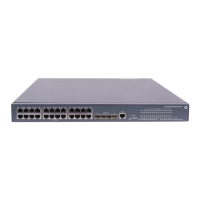121
Ste
Command Remarks
2. Enter
interface
view or port
group view.
• Enter Layer 2 Ethernet interface
view:
interface interface-type
interface-number
• Enter Layer 2 aggregate interface
view:
interface bridge-aggregation
interface-number
• Enter port group view:
port-group manual
port-group-name
Use any command.
• The configuration made in Layer 2 Ethernet
interface view applies only to the port.
• The configuration made in port group view
applies to all ports in the port group.
• The configuration made in Layer 2
aggregate interface view applies to the
aggregate interface and its aggregation
member ports. If the system fails to apply the
configuration to the aggregate interface, it
stops applying the configuration to
aggregation member ports. If the system
fails to apply the configuration to an
aggregation member port, it skips the port
and moves to the next member port.
3. Configure the
link type of
the ports as
trunk.
port link-type trunk
By default, all ports are access ports.
To change the link type of a port from trunk to
hybrid or vice versa, you must set the link type
to access first.
4. Assign the
trunk ports to
the specified
VLANs.
port trunk permit vlan { vlan-list | all }
By default, a trunk port carries only VLAN 1.
5. Configure the
PVID of the
trunk ports.
port trunk pvid vlan vlan-id
Optional.
By default, the PVID is VLAN 1.
NOTE:
fter confi
urin
the PVID for a trunk port, you must use the
port trunk permit vlan command to confi
ure
the trunk port to allow packets from the PVID to pass throu
h, so that the e
ress port can forward packets
from the PVID.
Assigning a hybrid port to a VLAN
A hybrid port can carry multiple VLANs. You can assign it to a VLAN in interface view (including Ethernet
interface view, and Layer 2 aggregate interface view) or port group view.
To assign a hybrid port to one or multiple VLANs:
Ste
Command Remarks
1. Enter system
view.
system-view N/A

